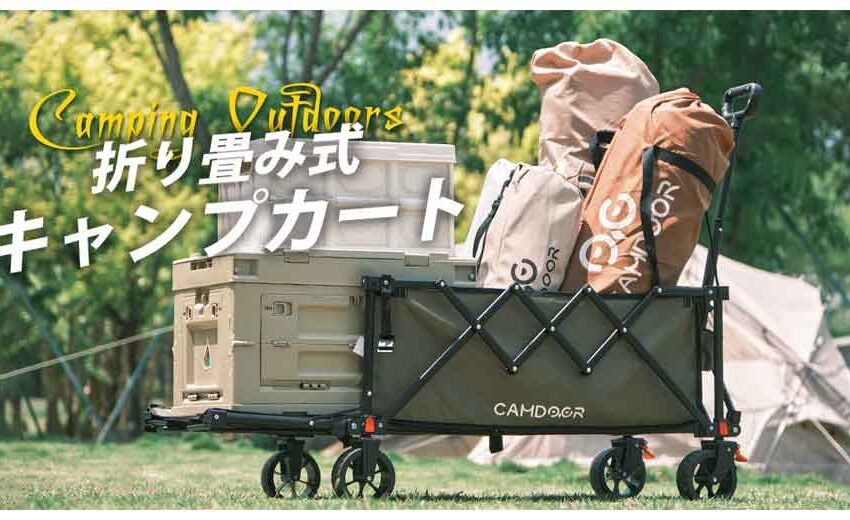The Modern Outdoor Wagon Rethought for Travelers

When most people hear “wagon,” they think of children’s toys or old-fashioned utility carts. But in today’s travel and outdoor culture—especially in Japan—the outdoor wagon has undergone a complete transformation.
Stylish, foldable, and ultra-functional, the outdoor wagon has become a must-have companion for families, campers, beachgoers, and even solo explorers. Whether you’re navigating a gravel campsite in Nagano or hauling supplies to a festival in Niigata, a good wagon can turn a difficult haul into a smooth, efficient journey.
Why Outdoor Wagons Are Perfect for Travel?
1. Compact Yet Capacious
Space is a premium when traveling in Japan, yet travelers still carry a surprising amount of gear—tents, cooking supplies, portable beds, even pets. A collapsible キャリーカート gives you large capacity without taking up precious space in your car trunk, camper van, or storage room.
When not in use, it folds into a slim, suitcase-sized package that fits easily in narrow apartment entrances or tight hotel corners.
2. Terrain-Friendly Wheels for Rural and Urban Settings
Japan’s terrain is incredibly diverse: rocky coastlines in the Izu Peninsula, forest trails in Nara, sandy beaches in Okinawa, and cobbled paths in Kyoto. High-quality outdoor wagons now come with all-terrain wheels that glide over gravel, grass, sand, or concrete.
Whether you’re at a crowded hanami site in spring or navigating a lantern-lit path during autumn, your load rolls smoothly behind you.
3. Ideal for Train and Ferry-Based Travel
Travelers in Japan often combine trains, buses, and ferries into one journey. Outdoor wagons equipped with lockable, foldable frames and carrying handles can be wheeled onto most JR trains and ferries, then folded up for easy storage. It’s a practical solution when your destination doesn’t allow vehicle access.
Real-Life Use Cases: Where Outdoor Wagons Shine
1. Campsites with Limited Vehicle Access
Many Japanese campsites—especially eco-friendly ones—do not allow cars to park near tents. That means carrying your gear from the lot to the site, sometimes over long distances. An outdoor wagon does this in a single trip, keeping your hands free and your back pain-free.
2. Summer Beach Days in Kanagawa or Chiba
From coolers to umbrellas to kids’ beach toys, beach trips can be logistically overwhelming. Outdoor wagons can handle sand better than plastic carts and double as mobile storage for wet gear at the end of the day.
3. Local Markets and Outdoor Events
Outdoor farmers’ markets in Japan often have little parking and require walking. Use your wagon to carry fresh produce, handmade goods, or even picnic setups. Some travelers even bring wagons to fireworks festivals, where public transport is packed but walking is essential.
4. Roadside Stops During Scenic Drives
If you’re driving through Hokkaido or the Noto Peninsula, roadside rest areas are perfect for spontaneous lunches and sightseeing stops. With a wagon, you can unload your cooking equipment, 折りたたみ椅子, and lunchbox in one smooth movement.
5. Traveling with Pets or Children
Wagons with enclosed sides and padded bases can double as strollers or resting spots for tired kids or small pets. In places like Yoyogi Park or Nara Deer Park, it’s a lifesaver when little legs give out halfway through the day.
Choosing the Right Outdoor Wagon: Key Factors for Smarter Travel
Not all wagons are created equal—especially when it comes to outdoor travel across Japan’s varied terrain. Whether you’re planning a weekend camping trip in the mountains or hauling gear across a crowded urban park, the right wagon can make or break your experience.
Here are the most important features to prioritize when choosing an outdoor wagon built for travel:
Sturdy Frame Construction
Look for steel or reinforced aluminum frames that can handle uneven terrain without flexing or warping. A solid frame ensures long-term durability across multiple seasons.
All-Terrain Wheels
Standard plastic wheels wear down fast and perform poorly on grass, gravel, or sand. Opt for rubberized or pneumatic tires with deep tread for smooth, stable movement on any surface.
Compact Foldability
Since travel in Japan often involves tight spaces—think compact car trunks, train compartments, and narrow campgrounds—a wagon that folds flat and locks in place for storage is essential.
Weather-Resistant Materials
Water-resistant fabric keeps your gear dry during sudden showers and is easier to clean after beach days or muddy hikes. UV resistance is also useful for long-term exposure.
Weight Capacity and Volume
Depending on your activity, choose a model that supports 80–120 kg and has deep sidewalls or modular compartments. This gives flexibility for carrying coolers, tents, chairs, or even kids and pets.
Ease of Control
Wagons with adjustable handles, brake systems, and swivel wheels are far easier to maneuver in tight, crowded, or sloped environments—such as festival grounds or hillside campsites.
Investing in a well-made outdoor wagon not only improves efficiency but also reduces the physical stress of transporting gear. You’ll spend less time making multiple trips—and more time enjoying the destination.
Final Thoughts
The outdoor wagon isn’t just a tool—it’s a travel partner. In a country where scenic beauty often lies beyond the reach of vehicles, it bridges the gap between convenience and nature.
From the coastlines of Shikoku to the forests of Yamanashi, an outdoor wagon gives you the freedom to bring everything you need without sacrificing mobility. For those who believe that every journey should be smooth from start to stop, the outdoor wagon is no longer optional—it’s essential.





